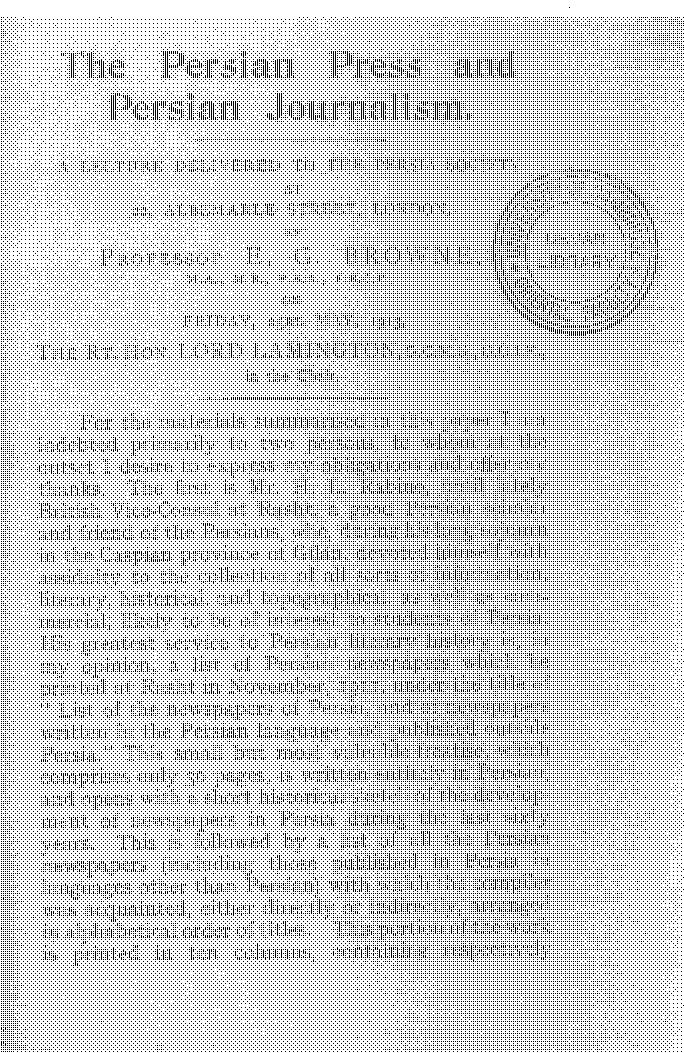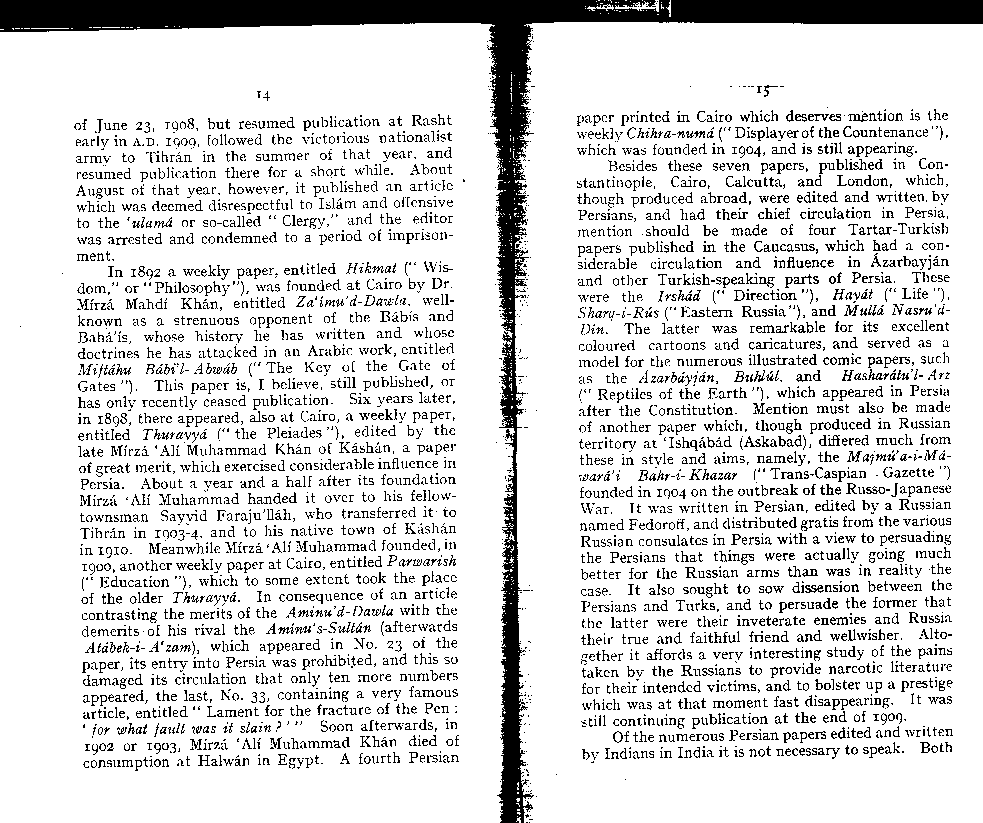
|
|
Abstract: Short discussion of early Persian-language newspapers, with a passing mention of the writings of Mirza Mahdi Khan, an opponent of the Bahá'ís, and his Arabic-language work Miftahu Babi'l-Abwab. |
The Persian Press and Persian Journalism:
A Lecture delivered to the Persia Society
by E. G. Browne
pages 1, 14-15London: Pub. for Persia Society by J. Hogg, 1913-05-23
1. Text
[page 1 (?)]For the materials summarised in this paper I am indebted primarily to two persons, to whom at the outset I desire to express my obligations and offer my thanks. The first is Mr. H. I. Rabino, until lately British Vice-Consul at Rasht, a good Persian scholar and friend of the Persians, who, during his long sojourn in the Caspian province of Gilan, devoted himself with assiduity to the collection of all sorts of information, literary, historical, and topographical, as well as commercial, likely to be of interest to students of Persia. His greatest service to Persian literary history is, in my opinion, a list of Persian newspapers which he printed at Rasht in November, 1911, under the title of "List of the Persian language and published outside Persia." This small but most valuable treatise, which comprises only 30 pages, is written entirely in Persian, and opens with a short historical sketch of the development of newspapers in Persia during the last sixty years. This is followed by a list of all the Persian newspapers - including those published in Persia in languages other than Persian) with which the compiler was acquainted either directly or indirectly, arranged in alphabetical order of titles. This portion of the work is printed in ten columns containing respectively...
[p. 14]
... of June 23, 1908 but resumed publication at Rasht early in A.D. 1909 followed the victorious nationalist army to Tihran in the summer of that year, and resumed publication there for a short while. About August of that year, however, it published an article which was deemed disrespectful to Islam and offensive to the 'ulama or so-called "Clergy," and the editor was arrested and condemned to a period of imprisonment.
In 1892 a weekly paper, entitled Hikmat ("Wisdom," or "Philosophy"), was founded at Cairo by Dr. Mirza Mahdi Khan, entitled Za'imu'd-Dawla, well-known as a strenuous opponent of the Babis and Bahá'ís, whose history he has written and whose doctrines he has attacked in an Arabic work, entitled Miftahu Babi'l-Abwab ("The Key of the Gate of Gates"). This paper is, I believe, still published, or has only recently ceased publication. Six years later, in 1898 there appeared, also at Cairo, a weekly paper, entitled Thurayya ("the Pleiades"), edited by the late Mirza 'Ali Muhammad Khan of Kashan, a paper of great merit, which exercised considerable influence in Persia. About a year and a half after its foundation Mirza 'Ali Muhammad handed it over to his fellow-townsman Sayyid Faraju'llah, who transferred it to Tihran in 1903-4, and to his native town of Kashan in 1910. Meanwhile Mirza 'Ali Muhammad founded, in 19000, another weekly paper at Cairo, entitled Parwarish ("Education "), which to some extent took the place of the older Thurayya. In consequence of an article contrasting the merits of the Aminu'd-Dawla with the demerits of his rival the Aminu's-Sultan (afterwards Atabek-i-A'zam), which appeared in No. 23 of the paper, its entry into Persia was prohibited, and this so damaged its circulation that only ten more numbers appeared, the last, No. 33, containing a very famous article, entitled "Lament for the fracture of the Pen: ' for what fault was it slain? ' "Soon afterwards, in 1902 or 1903, Mirza 'Ali Muhammad Khan died of consumption at Halwan in Egypt. A fourth Persian
[page 15]
paper printed in Cairo which deserves mention is the weekly Chihra-numa ("Displayer of the Countenance"), which was founded in I904, and is still appearing.
Besides these seven papers, published in Constantinople, Cairo, Calcutta, and London, which, though produced abroad, were edited and written by Persians, and had their chief circulation in Persia, mention should be made of four Tartar-Turkish papers published in the Caucasus, which had a considerable circulation and influence in Azarbayjan and other Turkish-speaking parts of Persia. These were the Irshad ("Direction "), Hayat ("Life"), Sharq-i-Rus ("Eastern Russia"), and Mulla Nasru'd-Din. The latter was remarkable for its excellent coloured cartoons and caricatures, and served as a model for the numerous illustrated comic papers, such as the Azarbayjan, Buhlul, and Hasharatu'l-Arz ("Reptiles of the Earth "), which appeared in Persia after the Constitution. Mention must also be made of another paper which, though produced in Russian territory at 'Ishqabad (Askabad), differed much from these in style and aims, namely, the Majmu'a-i-Ma-wara'i Bahr-i-Khazar ("Trans-Caspian Gazette") founded in 1904 on the outbreak of the Russo-Japanese War. It was written in Persian, edited by a Russian named Fedoroff, and distributed gratis from the various Russian consulates in Persia with a view to persuading the Persians that things were actually going much better for the Russian arms than was in reality the case. It also sought to sow dissension between the Persians and Turks, and to persuade the former that the latter were their inveterate enemies and Russia their true and faithful friend and well-wisher. Altogether it affords a very interesting study of the pains taken by the Russians to provide narcotic literature for their intended victims, and to bolster up a prestige which was at that moment fast disappearing. It was still continuing publication at the end of 1909....
2. Image scans (apologies for the poor-quality of the scans; click image for larger version)

|
|
